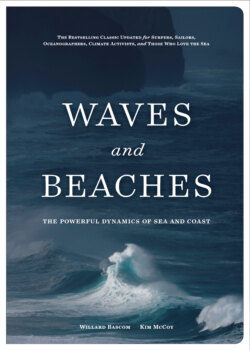Читать книгу Waves and Beaches - Kim McCoy - Страница 24
На сайте Литреса книга снята с продажи.
THE FIRST WAVE THEORY
ОглавлениеIn 1802, Franz von Gerstner (a German-Bohemian working in Prague) produced a nonlinear wave theory. He described how water particles in a wave move in circles, and he pointed out that those in the crest of a wave move in the direction of wave advance, and those in the trough move in the opposite direction. Gerstner noted that before returning to its original position, each water particle at the surface traces a circular orbit, the diameter of which is exactly equal to the height of the passing wave. He observed that the surface trace of a wave is approximately a trochoid, the curve described by a point on a circle as the circle is rolled along the underside of a line (see figure 8). Presumably, he knew that if the wave height is small compared to the length, as it is for most water waves, the shape of the trochoid approaches that of a sine curve.
FIGURE 8: Geometrical waveforms for waves of equal lengths and heights but different shapes. Top: A trochoidal wave is generated by point A as the outer circle rolls along the underside of line B. Bottom: A sine wave is generated by projecting the position of point A to equal increments of time as it rotates about a stationary center C.
Such was the theoretical beginning. Gerstner’s work was found later to have several inconsistencies, but it attracted the attention of the Weber brothers of Germany, Ernst and Wilhelm, who became the first wave science experimentalists. In 1825 they published their findings on using a glass-walled tank, which began the formal study of waves under controlled conditions. The flat-sided tank—which offered the opportunity to study one wave at a time at eye level and the chance to repeat an experiment over and over until understanding was achieved—overcame the major difficulties of studying waves in nature.
The Weber brothers discovered that waves are reflected from a vertical wall without loss of energy, and they watched suspended particles to confirm the theory that the circular orbits diminished in size with increased depth. They found that, near the bottom of the tank, the orbits were greatly flattened.
WAVE CHANNEL A wave channel (wave flume) can create waves with controlled periods and heights to study wave forces on sediments, beach faces, buoys, and structures. OSU O.H. Hinsdale Wave Reserch Laboratory
These early theoreticians devised equations in which an endless train of perfect waves, all exactly alike, moved across an ocean of infinite breadth and depth. Their trains were an unreal abstraction, but the method was the most reasonable way to begin to work out the relationships between period and wave length and velocity for sinusoidal ocean waves. These equations were then applied to the waves observed in wave channels.
In the mid-1800s, there was another great flurry of experimental work. A Scotsman named John Scott Russell, for example, built a channel about 20 feet (6 m) long. Near one end was a removable gate that created a small reservoir when lowered in place. To make waves, Russell would suddenly raise the gate and allow the water to rush down the channel as a solitary wave or wave of translation. This impulse produced normal waves, which would then reflect back and forth between the ends. With this experiment, Russell had made the first careful measurements of wave velocity.
The development of equations and the serious attempt to understand theoretically what the waves in the tank and the ocean were doing was a big step. But we must remember that with equations the experimenter has true models in the wave channel; without equations the wave tank is only a plaything.
The theoretical and experimental work done today is more complicated because it is now commonly known that ocean waves are not really sinusoidal, or any other “pure” mathematical shape. Now, real ocean waves are dealt with statistically, as combinations of great numbers of small waves. However, model work today is done for the same reason that it was done long ago—to simplify the problems by working under controlled conditions. The Mediterranean cove of the past has been replaced by the experimental wave channel and the irregular swell by precision generators.
Today, many fluid mechanics laboratories have facilities for modeling waves and determining their effects on beaches and ships. These facilities range from the tabletop ripple-makers to huge tanks that can create breakers 8 feet high on full-size models. An example of a wave channel is shown in the photo on page 55.
